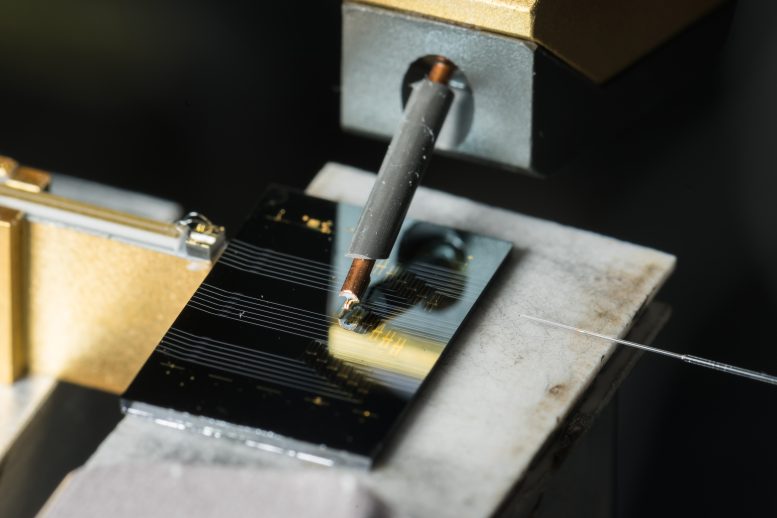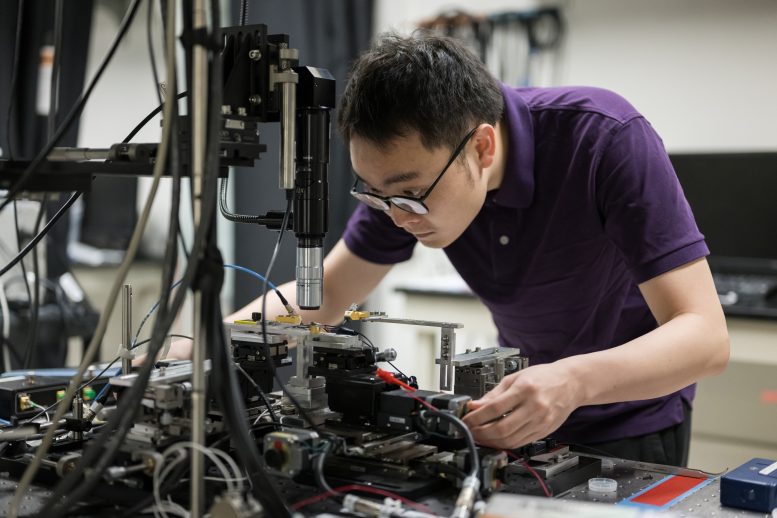
University of Rochester researchers created a chip-scale microcomb laser with an innovative design that allows users to control the optical frequency comb simply by switching on a power source. Credit: University of Rochester photo / J. Adam Fenster
Lasers created at the University of Rochester pave the way for new on-chip frequency comb generators.
Optical frequency combs, devices essential for measuring light, have transformed fields like metrology, spectroscopy, and atomic clock development. However, the difficulty in producing frequency comb generators on a microchip scale has restricted their integration into common technologies, such as handheld electronics.
In a study published in
But while scientists have made progress in prototyping microcombs, they have had limited success producing viable versions that can be applied in practical devices. Obstacles include low power efficiency, limited controllability, slow mechanical responses, and the need for sophisticated system pre-configuration.

Electrical and computer engineering PhD student Zhengdong Gao adjusts a new “all in one” microcomb laser device created in the lab of professor Qiang Lin. Credit: University of Rochester photo / J. Adam Fenster
A Simplified Approach
A team of researchers led by Qiang Lin, a professor in Rochester’s Department of Electrical and Computer Engineering and at the Institute of Optics, created a unique approach to solve these challenges in a single device.
According to Jingwei Ling, an electrical and computer engineering PhD student in Lin’s lab and the lead author of the paper, previous approaches usually rely on a single-wavelength laser injected into a nonlinear converter that can transfer the single wavelength into multiple wavelengths, forming the optical comb.
“We eliminated the single wavelength because that’s going to degrade the system’s efficiency,” says Ling. “We instead have all the comb itself being amplified in a feedback loop inside the system, so all the wavelengths get reflected and enhanced inside a single element.”
The simplicity of the “all in one” microcomb laser results in lower power demands, lower costs, high tunability, and a turnkey operation.
“It is easy to operate,” says coauthor Zhengdong Gao, also an electrical and computer engineering PhD student in Lin’s lab. “The previous methods make it hard to excite the comb, but with this method, we only need to switch on the power source, and we can control the comb directly.”
Hurdles remain for implementing these microcomb lasers, particularly with developing fabrication techniques to create such tiny components within the tolerances necessary for manufacturing. However, the researchers are hopeful that their devices can be used for applications such as telecommunications systems and light detection and ranging (LiDAR) for autonomous vehicles.
Reference: “Electrically empowered microcomb laser” by Jingwei Ling, Zhengdong Gao, Shixin Xue, Qili Hu, Mingxiao Li, Kaibo Zhang, Usman A. Javid, Raymond Lopez-Rios, Jeremy Staffa and Qiang Lin, 17 May 2024, Nature Communications.DOI: 10.1038/s41467-024-48544-2
The Defense Advanced Research Projects Agency and the National Science Foundation supported this research.